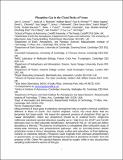| dc.contributor.author | Greaves, Jane S | |
| dc.contributor.author | Richards, Anita MS | |
| dc.contributor.author | Bains, William | |
| dc.contributor.author | Rimmer, Paul B | |
| dc.contributor.author | Sagawa, Hideo | |
| dc.contributor.author | Clements, David L | |
| dc.contributor.author | Seager, Sara | |
| dc.contributor.author | Petkowski, Janusz J | |
| dc.contributor.author | Sousa-Silva, Clara | |
| dc.contributor.author | Ranjan, Sukrit | |
| dc.contributor.author | Drabek-Maunder, Emily | |
| dc.contributor.author | Fraser, Helen J | |
| dc.contributor.author | Cartwright, Annabel | |
| dc.contributor.author | Mueller-Wodarg, Ingo | |
| dc.contributor.author | Zhan, Zhuchang | |
| dc.contributor.author | Friberg, Per | |
| dc.contributor.author | Coulson, Iain | |
| dc.contributor.author | Lee, E’lisa | |
| dc.contributor.author | Hoge, Jim | |
| dc.date.accessioned | 2021-10-27T19:56:58Z | |
| dc.date.available | 2021-10-27T19:56:58Z | |
| dc.date.issued | 2020 | |
| dc.identifier.uri | https://hdl.handle.net/1721.1/133846 | |
| dc.description.abstract | © 2020, The Author(s), under exclusive licence to Springer Nature Limited. Measurements of trace gases in planetary atmospheres help us explore chemical conditions different to those on Earth. Our nearest neighbour, Venus, has cloud decks that are temperate but hyperacidic. Here we report the apparent presence of phosphine (PH3) gas in Venus’s atmosphere, where any phosphorus should be in oxidized forms. Single-line millimetre-waveband spectral detections (quality up to ~15σ) from the JCMT and ALMA telescopes have no other plausible identification. Atmospheric PH3 at ~20 ppb abundance is inferred. The presence of PH3 is unexplained after exhaustive study of steady-state chemistry and photochemical pathways, with no currently known abiotic production routes in Venus’s atmosphere, clouds, surface and subsurface, or from lightning, volcanic or meteoritic delivery. PH3 could originate from unknown photochemistry or geochemistry, or, by analogy with biological production of PH3 on Earth, from the presence of life. Other PH3 spectral features should be sought, while in situ cloud and surface sampling could examine sources of this gas. | en_US |
| dc.language.iso | en | |
| dc.publisher | Springer Science and Business Media LLC | en_US |
| dc.relation.isversionof | 10.1038/S41550-020-1174-4 | en_US |
| dc.rights | Article is made available in accordance with the publisher's policy and may be subject to US copyright law. Please refer to the publisher's site for terms of use. | en_US |
| dc.source | arXiv | en_US |
| dc.title | Phosphine gas in the cloud decks of Venus | en_US |
| dc.type | Article | en_US |
| dc.contributor.department | Massachusetts Institute of Technology. Department of Earth, Atmospheric, and Planetary Sciences | |
| dc.contributor.department | Massachusetts Institute of Technology. Department of Physics | |
| dc.contributor.department | MIT Kavli Institute for Astrophysics and Space Research | |
| dc.contributor.department | Massachusetts Institute of Technology. Department of Aeronautics and Astronautics | |
| dc.relation.journal | Nature Astronomy | en_US |
| dc.eprint.version | Author's final manuscript | en_US |
| dc.type.uri | http://purl.org/eprint/type/JournalArticle | en_US |
| eprint.status | http://purl.org/eprint/status/PeerReviewed | en_US |
| dc.date.updated | 2021-09-21T18:18:43Z | |
| dspace.orderedauthors | Greaves, JS; Richards, AMS; Bains, W; Rimmer, PB; Sagawa, H; Clements, DL; Seager, S; Petkowski, JJ; Sousa-Silva, C; Ranjan, S; Drabek-Maunder, E; Fraser, HJ; Cartwright, A; Mueller-Wodarg, I; Zhan, Z; Friberg, P; Coulson, I; Lee, E; Hoge, J | en_US |
| dspace.date.submission | 2021-09-21T18:18:46Z | |
| mit.journal.volume | 5 | en_US |
| mit.journal.issue | 7 | en_US |
| mit.license | PUBLISHER_POLICY | |
| mit.metadata.status | Authority Work and Publication Information Needed | en_US |
